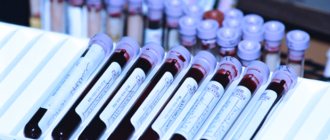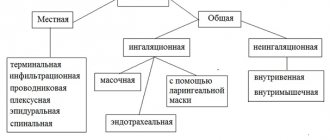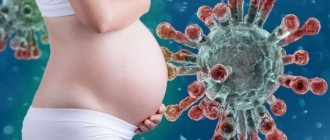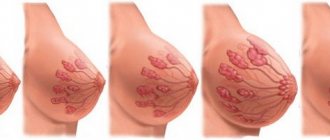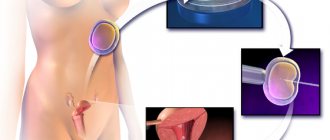When can I try again?
For many women, in vitro fertilization is the only chance to become a mother, and when 2 weeks after IVF the test results are negative, severe depressive states often develop, and consultation and support from a psychologist is often required.
Miscarriage
As with natural pregnancy, miscarriages often occur after IVF; this happens before 10-12 weeks. Spontaneous abortion occurs against the background of the development of genetic abnormalities, exacerbation of chronic diseases, hormonal imbalances, stress, and missed abortion syndrome.
To save a child, a woman sometimes has to be kept for all 9 months, but then she can immediately give birth to not one, but two or three babies at once - with artificial insemination, the probability of a multiple pregnancy is quite high.
Signs of a miscarriage are nagging pain in the lower abdomen, lumbar region, spotting, fever, chills, severe weakness, frequent bouts of dizziness. If you experience at least one of these symptoms after the transplant, immediately call your doctor or call an ambulance.
A series of unsuccessful IVF attempts is fraught not only with psycho-emotional disorders, but also with the development of other negative consequences:
- disturbances in the functioning of the digestive system;
- rapid weight gain;
- severe renal and hepatic pathologies;
- exacerbation of old or development of new reproductive and gynecological diseases;
- hormonal imbalances, active hair growth on the face, arms, legs, disruptions in the menstrual cycle, diseases of the mammary glands, early menopause;
- endocrine diseases;
- With each new attempt, the risk of developing ovarian cancer in the future increases.
If an IVF attempt is unsuccessful, it is important to establish the true reason why the pregnancy did not take place. It depends on which factor or combination of reasons has an influence whether the chances of pregnancy will increase during the subsequent protocol. The reasons for failure can be very different.
Often, embryos obtained from the fertilization of maternal eggs with the sperm of a husband or donor do not meet strict quality requirements. They do not demonstrate high vitality; in fact, they are not strong and healthy. Such embryos have virtually no chance of successfully implanting.
Embryos may be injured during transfer, for example if the transfer is too fast. They also die, pregnancy does not occur. The reasons may lie in the insufficient quality of biological materials - oocytes and sperm.
Often the protocol ends unsuccessfully due to too aggressive hormonal stimulation of the ovaries in the first phase of the menstrual cycle in the first protocol. At the same time, an excess of estrogen and FSH occurs in the woman’s body, and ovarian hyperstimulation syndrome may develop, which significantly reduces the already far from one hundred percent probability of successful completion of the protocol.
A woman can get the flu or ARVI after the transfer of fertilized eggs into the uterine cavity. Her long-standing chronic diseases may worsen under the influence of aggressive hormonal therapy. Sometimes the reason for the lack of pregnancy after an IVF attempt is autoimmune processes, as well as genetic incompatibility of partners. Sometimes doctors are unable to obtain a sufficient number of eggs, and sometimes a large number of fertilized eggs are not selected for suitability for transfer.
Quite often, implantation is hampered by the patient’s complicated obstetric history - endometriosis, pathologies of the uterus and cervix can be a significant obstacle to cherished motherhood.
Even if pregnancy has occurred, and this is confirmed by ultrasound and hCG tests, after IVF there is a fairly high probability of miscarriage or early miscarriage. This again can be a consequence of hormonal therapy, and is also caused by a variety of reasons.
Pregnancy after IVF is special; such expectant mothers require more careful monitoring. But even the best doctors, alas, cannot always prevent the death and detachment of the fertilized egg.
Unsuccessful IVF, no matter how it ends, may be a consequence of the woman’s age. The optimal age, when the success rate is highest, is considered to be up to 35 years old, then every year the probability of a successful pregnancy decreases.
The question of how many days later you can do repeated IVF is not entirely correct. In each specific case, individual deadlines are established, which depend on the woman’s well-being, health status and the reasons why the first protocol was unsuccessful.
The most common period a woman is given for recovery is three months. During this time, the woman usually has time to calm down after the previous defeat, gain hope and do all the necessary tests and examinations.
However, if the previous attempt was carried out without hormonal stimulation of the ovaries, in a natural cycle, you can repeat the attempt in the next menstrual cycle, that is, in two weeks.
After a miscarriage or frozen pregnancy, a woman usually needs more time to recover, since in most cases such situations require curettage of the uterine cavity. She must first undergo treatment with antibiotics and anti-inflammatory drugs, then begin rehabilitation and, finally, preparation. The recommended pause in this case is six months.
Reasons for unsuccessful IVF attempts
Unfortunately, not all IVF attempts lead to such a desired pregnancy; the percentage of unsuccessful attempts is very high and varies according to different sources.
Quite often, the reasons for IVF failure are associated with the non-viability of embryos and their reduced ability to divide.
In addition to this, there are other reasons, which include:
- Stopping the development of the embryo after successful fertilization.
- Pathological changes in the endometrium (chronic inflammatory diseases of the endometrium, endometrial polyps, hyperplasia, oncopathology).
- Diseases associated with the fallopian tubes.
- Infectious and inflammatory diseases of the reproductive system.
- Genetic pathology in future parents, as well as genetic abnormalities of the embryo.
- Individual incompatibility of spouses.
- Pathology of the immune system (antibodies in a woman’s body that prevent pregnancy).
- Endocrine pathology (hormonal imbalances).
- Metabolic disorders (obesity).
- Bad habits (smoking, alcohol, drugs).
- The woman does not comply with the instructions of the fertility specialist and violates the treatment regimen.
- Disadvantages of diagnosing concomitant pathology.
- Eggs that are not suitable for fertilization.
- Spermatozoa of reduced quality.
- Chronic concomitant pathology (liver, kidneys, gastrointestinal tract, respiratory system, genital organs).
- Medical errors.
Other factors that could lead to the death of the embryo cannot be excluded. A very important aspect in this matter is the state of health and physiological reserves of the expectant mother’s body, the ability of her body to implant an embryo and carry a pregnancy. How is IVF pregnancy different from regular pregnancy? Apart from the method of getting the embryo into the uterine cavity, strictly speaking, nothing.
Failure after IVF is not a death sentence, and it often takes several attempts to achieve the desired pregnancy. For many couples, maintaining hope and emotional stability after an unsuccessful attempt at in vitro fertilization is quite a difficult task, so this issue is also worth considering.
What is IVF, in what cases is it prescribed?
In vitro fertilization allows women who cannot get pregnant naturally to give birth to their first child, or second or third child.
The procedure is complex, it is carried out strictly if there are indications - certain forms of physiological male and female infertility, if the reason for the lack of conception could not be identified.
The main indications for IVF are obstruction or absence of the fallopian tubes, endometriosis, serious hormonal disorders that could not be eliminated with drug therapy, defective ovarian function, and low sperm quality.
Contraindications – congenital pathologies of the uterus, fibroids and other malignant and benign neoplasms, any acute inflammatory processes, mental disorders.
IVF stages:
- ovarian stimulation - using hormonal drugs;
- egg puncture, sperm collection;
- artificial fertilization of an egg;
- growing the embryo in vitro for 1-5 days;
- embryo transfer into the uterine cavity.
All these steps do not seem so difficult, but most often it is difficult for women mentally and physically to endure the preparation and procedure of embryo transfer itself.
Do not forget about the cost of IVF - the average price is 1200-5000 thousand dollars, depending on the type of protocol, types of preliminary diagnostics, necessary medications, and the level of the clinic.
We suggest you read: Duphaston to induce menstruation, what are the instructions for using the drug when menstruation is delayed
Therefore, before thinking about IVF, you need to identify and eliminate possible causes that prevent conception - more than 50% of couples who do not have children do not need in vitro fertilization.
Do not rush to take a pregnancy test the day after IVF, as with natural fertilization, the coveted 2 stripes can be seen only 10-14 days after conception.
Whatever the result of the home test, be sure to donate blood for hCG levels - the level of this hormone always increases after pregnancy.
Unsuccessful IVF and the psychological aspect
If all the tests confirm that you can become parents, but for some reason this does not happen, then experienced reproductive specialists in this case advise paying close attention not so much to physiological as to psychological factors. Hidden fears and subconscious attitudes can influence the outcome of artificial insemination no less than infections and pathologies. Among the many psychological reasons for IVF failure, doctors identified 5 main ones:
- a woman’s unpreparedness for motherhood, the inability to imagine herself in the role of a mother;
- distrust of the attending physician and medical staff of the clinic;
- doubts about the spouse and his readiness for fatherhood;
- attitude towards artificial insemination as something unnatural and dangerous;
- disbelief in one’s own pregnancy, a deliberate belief in the negative outcome of IVF.
Most often, these fears do not reveal themselves. Outwardly, a woman may seem calm and confident, but subconscious attitudes continue to work and disrupt one pregnancy after another. It is often simply impossible to get rid of hidden psychological barriers on your own. It’s not for nothing that many clinics involved in reproductive medicine have a full-time psychologist. If the first protocol fails, reproductive specialists will certainly include psychological consultation in the list of mandatory measures.
What examinations need to be completed?
After the end of the next menstruation, which completed an unsuccessful protocol, the woman must do an ultrasound of the pelvic organs, as well as hysteroscopy, which will show all the features of the uterus and endometrium. It is necessary to donate blood for hormones, general and extended blood tests, and urine tests.
Couples over 35 years old, as well as couples who have had three or more unsuccessful transplants, need to visit a geneticist and do the necessary compatibility tests and karyotyping. An immunogram done in the clinic will help identify possible immune factors in which a woman’s body rejects pregnancy as something foreign.
If a miscarriage or miscarriage occurs, the woman will have to do all the same tests, and in addition to them, it is advisable to obtain a conclusion from a genetic laboratory that examined embryonic tissue after miscarriage or spontaneous miscarriage. With a high degree of probability, such a study will show whether the baby had genetic pathologies or whether his death was due to other reasons.
Why does natural pregnancy occur after IVF?
Using modern methods of infertility treatment, doctors can achieve pregnancy even in extremely difficult situations.
If the patient is over 45 years old or it is not possible to obtain high-quality embryos during IVF, a program with donor oocytes can be recommended.
If the condition of the uterine cavity or endometrium does not allow you to successfully carry a fetus, you can turn to the help of a surrogate mother.
Reproductive medicine does not stand still. Just half a century ago, the IVF procedure itself seemed fantastic, so, probably, implantation problems will also soon be easily solved.
Medicine does not stand still, but even in the most modern IVF centers the probability of becoming pregnant after artificial insemination is no more than 37%, in foreign clinics this figure is higher - approximately 56%., but the cost of the procedure differs from our prices several times, upward , naturally.
Doctors prescribe a repeat IVF procedure after 3-6 months, less often after the end of the second menstruation; all this time the woman needs to restore her moral and physical strength.
After an unsuccessful protocol, you should re-take all the necessary tests, do an ultrasound - often only after the first attempt it is possible to identify the true reason for the lack of natural conception.
In some forms of infertility, the chance of becoming pregnant naturally after an in vitro fertilization protocol increases. At the preparatory stage, the ovaries are actively stimulated, this effect persists for a long time.
Pregnancy after IVF - how to increase your chances of conceiving:
- positive emotional background, lack of stress;
- proper and balanced nutrition;
- moderate regular physical activity;
- adherence to daily routine;
- strengthening the immune system.
Every couple needs to learn that IVF is only a chance to give birth to a long-awaited child, but not a guaranteed solution to the problem.
According to statistics, approximately every fourth woman managed to become pregnant on her own after unsuccessful IVF; the chances for natural conception are especially high in the first 4-6 weeks after the protocol.
Reasons for spontaneous conception after IVF:
- couples diagnosed with infertility stop using contraception, which often leads to a primary or repeat pregnancy after IVF;
- intensive hormonal support - throughout the entire preparatory stage, the woman takes many medications that stimulate fertile functions in the body;
- all preliminary preparation is aimed at setting the body up for conception and gestation, the effect persists for another 1–2 years even after unsuccessful IVF;
- couples who are ready for in vitro fertilization radically change their lifestyle - they follow a daily routine, eat right, lead an active lifestyle, give up addictions, all this has a positive effect on the functioning of the reproductive system and the entire body as a whole.
When a woman has her first child, even after artificial insemination, her psycho-emotional state significantly improves, and the feeling of inferiority disappears - these factors often interfere with effective infertility treatment.
When male infertility is diagnosed, the absence or complete obstruction of the fallopian tubes, or some forms of uterine hypoplasia, conception naturally after IVF is simply impossible; giving birth to a baby is possible only after successful artificial insemination.
How effective is IVF?
In vitro fertilization is often talked about as if it were a magical procedure that provides a one hundred percent guarantee of pregnancy.
Such an illusion can be extremely dangerous, because the effectiveness of in vitro fertilization is far from it. And often after unsuccessful IVF, reviews of this procedure become unfairly negative. Even in America and Europe, in highly professional clinics that are equipped with the best and most modern equipment, the probability of pregnancy after the first in vitro fertilization is 50-55 percent. In our country, the effectiveness of IVF is currently slightly less and is approximately 30-50 percent.
It is scary for a potential mother to think about such numbers, realizing that even an unsuccessful second IVF attempt is possible. However, these are official statistics that you cannot argue with.
For this reason, even before the first fertilization, you should realize that the chance of its successful outcome is, at best, 50 percent. Therefore, when thinking about an unsuccessful IVF attempt and what to do next, there is no need to despair. You may need a more thorough examination of the couple, a course of rehabilitation, and then another, or maybe several attempts.
Our clinic is equipped with the most modern equipment. In addition, we employ experienced specialists who constantly improve their skills. Therefore, our IVF efficiency is close to European indicators and is 40-50%. Make an appointment - take a step towards the long-awaited motherhood.
Probability of successful procedure
Despite the level of development of modern reproductive medicine, no one can guarantee the success of the attempt. This should be well understood at the preparatory stage for the first protocol. Failure is possible and this should be recognized and understood from the very beginning, so that later it does not turn into a serious psychological problem.
The percentage of probability of a successful pregnancy depends on the health status of the spouses, their age, the quality of the biological material, as well as a host of associated factors, not all of which are obvious to scientists and doctors today. According to the most optimistic forecasts, no more than 45-50% of women under the age of 35 can become pregnant on the first attempt with IVF. If a woman is 37-38 years old, the probability of success of the attempt is no more than 35%, and if a woman decides to become a mother at 40 years old, then the success rate of IVF is reduced to 19%. At 42, only 8% of women become pregnant after their first IVF attempt.
The likelihood of conceiving a baby in the second or third protocol increases significantly, but after the fourth attempt, the chances of pregnancy decrease to a basic 10-12% instead of 45%.
We invite you to read: Daily exercises and breathing exercises for pregnant women
A repeated protocol almost always has a better chance of success than the first one. This is because when trying again, there is often no need to stimulate the ovaries. If during the first stimulation a sufficient number of eggs are obtained and several oocytes are left frozen in the cryobank, then a cryoprotocol is prescribed. Transferring embryos into the uterus of a woman who has rested from aggressive hormonal influences significantly increases the likelihood of a successful pregnancy.
Even the stimulated second or third protocol is considered more successful than the first. So, with the first protocol, the probability of pregnancy after IVF is about 45%. In the second protocol, the probability of pregnancy reaches 60%. However, after the third attempt, the chances decrease significantly and amount to no more than 15-20%.
Any aggravating factors - ovarian hyperstimulation, tumors in the uterus, depleted endometrium, chronic diseases - reduce the likelihood of success by approximately 5% for each factor. However, everyone always has a chance to get pregnant. Gynecologists know cases where IVF results in successful pregnancy in women 50 years of age and older, as well as in women with severe forms of infertility.
The following information will be useful as a “bonus”: the first or second IVF attempts, if they were carried out with hormonal support, significantly increase the likelihood that a woman’s reproductive system will begin to work more actively after a hormonal “shake-up”. Therefore, in 25% of couples, after an unsuccessful attempt or two, it is likely that pregnancy will occur from natural conception.
Usually this happens during the period of recovery and preparation for the next attempt at in vitro fertilization. Naturally, such an outcome is likely only in women who have preserved the ovulatory function of the ovaries and the ovaries themselves, and there is no obstruction of the fallopian tubes.
To all of the above, all that remains to be added is that there is no point in delaying the next attempt. A long break, as well as excessive haste, can have a bad effect on the outcome of the next attempt. Listen to your doctor, follow his recommendations and everything will definitely work out.
Preparing for IVF
How should you behave during the break between attempts? There are several fundamental recommendations, these include:
- Before an attempt and during the break between them, it is better for the couple to rest, including mentally. Go on a trip, learn a new hobby, read an interesting book.
- Engage in light physical exercise, especially those that improve blood flow in the pelvic area, swimming, and aerobics.
- Contact a therapist and undergo a full examination of all systems and organs; this is necessary in order to minimize the risks of a repeated unsuccessful attempt.
- Add as many foods rich in vitamins and minerals to your diet as possible.
- Have a sex life. During this time, give up the very idea of getting pregnant, have sex at will, and not according to a schedule or prescription.
- Work on stabilizing your psychological state, as stress reduces your chances of pregnancy.
There are many reasons why in vitro fertilization fails, but many of them can be easily corrected and their impact can be minimized. It is also important to remember that the IVF process should be handled by a qualified gynecologist-reproductologist who will help you easily get pregnant and carry such a desired baby.
What determines the probability of success?
The success of an IVF procedure depends on many factors, and not all of them can be controlled. However, a number of good decisions made by you and your doctor will increase the chances of a successful pregnancy.
Choosing a clinic
This is a major factor that can be controlled by the patients themselves. Everything else depends not so much on them, but on the doctors.
In different clinics, IVF success rates differ quite significantly. In leading centers in Moscow, the pregnancy rate per transfer reaches 50-55% (in women under 35 years of age with tubal factor infertility). While the world average is only 25-30% of pregnancies per transfer. Obviously, there are many clinics that drag down these statistics. The probability of pregnancy in them is only 20-25%, and in some categories of patients (age after 35 years, uterine factor infertility) it is significantly less
There are several reasons why pregnancy is common in one clinic and rare in others:
Qualification of doctors. More reputable institutions can attract the best specialists who come here in search of professional growth and decent compensation for their work. It depends on the doctor whether the stimulation program will be chosen correctly and the procedures performed (follicle puncture, embryo transfer). He prepares the endometrium and decides whether to transfer the embryos or postpone this procedure until the next cycle. The qualifications of a reproductologist are the most important factor in the success of the IVF procedure.
Equipment. A well-equipped embryology laboratory, the use of the latest media, high-quality consumables - all this increases the cost of the clinic’s services, but increases the effectiveness of IVF.
New approaches. Good clinics regularly send their doctors to European and American conferences and symposia. They travel to the leading reproductive centers of the world to exchange experiences. Therefore, new technologies and techniques are coming from the West to increase the effectiveness of IVF and the safety of this procedure.
Full diagnostics. Unsuccessful IVF or miscarriage may be the reason for underexamination of the patient. Incomplete diagnosis of hormonal profile, blood coagulation system, endometrial condition, infectious diseases, etc. leads to a procedure with obviously low chances of a successful outcome.
Choosing a good clinic is the best thing a patient can do to prevent IVF failure. You need to choose not by price, not by proximity to home or convenient metro station. It is better to contact a reputable clinic with good statistical indicators. Statistics are often published on the website of the medical institution. If it is not there, it is highly likely that the clinic has nothing to brag about - no one wants to advertise bad statistics. Statistical data may be provided to you upon request.
Lifestyle
Another factor controlled by patients is their lifestyle. What you need to do with infertility treatment:
- quit smoking;
- normalize body weight if it is excessive;
- increase the amount of vegetables and fruits in the diet, reduce the consumption of fatty foods of animal origin;
- do not drink alcohol in excessive quantities, more than 3 times a week;
- exclude any drugs and psychoactive substances;
- lead an active lifestyle, practice physical activity at least 45 minutes a day;
- exclude any extramarital sexual contacts to prevent infection with sexually transmitted infections.
All this will help normalize the immune response, blood clotting, blood supply to the genitals, and the removal of toxic substances from the body.
Detection and treatment of diseases
In most cases, a woman begins to be thoroughly examined to determine the cause of unsuccessful infertility treatment only after 2 unsuccessful IVF attempts, or 2 spontaneous abortions in a row. Until this time, miscarriage or lack of pregnancy after embryo transfer is considered an element of chance.
But many clinics conduct a full examination of the patient even before entering into the first IVF protocol. This increases the success rate. Indeed, if pathological conditions are detected (infectious diseases of the urogenital tract, chronic endometritis, disorders in the hemostasis system), treatment is required before a woman can become pregnant and bear a child.
Of course, additional diagnostics require additional time and money. However, they are not comparable to the expenditure of the same resources that a married couple spends on repeated and unsuccessful attempts to get pregnant and carry a pregnancy to term. Therefore, you should not be outraged that you are prescribed too many tests. It is better to initially exclude all possible causes of unsuccessful IVF.
Reviews
Women are not shy and do not hold back their emotions when leaving reviews about their sad experience of unsuccessful IVF. In themselves, these reviews are excellent psychotherapy for those who are looking for answers to numerous questions after the hope of pregnancy has collapsed. Please note that some have made 2-3 attempts, while others are going to 8 or 9 IVFs and are full of optimism.
Reviews from women vary. Some managed to get pregnant on the second try, while others got pregnant on the fourth or seventh. According to women, doctors do not in all cases establish the true reason for the negative result of the protocol.
There are quite a lot of good reviews about the so-called “marathon” protocol, in which a woman artificially suppresses ovulation with hormones for several months, she does not have periods, she is practically in menopause. And then the drugs are stopped and a quick protocol is carried out. Typically this method is used after several unsuccessful attempts.
What to do if there were unsuccessful IVF attempts? See the next video about this.
According to women's reviews, which exist in large numbers on thematic forums on the Internet, one of the most important is the psychological attitude before the next attempt. Thus, women who worked with a psychologist, attended seminars on preparation for IVF, and used the services of a psychotherapist are more likely to become pregnant than women who are simply fixated on possible failure and limit themselves in communicating with anyone on this topic.
Most often, women note that the second or third protocol turned out to be successful. Less often - 5-6. Cases when women went “to victory” are rare, but they do exist - 8 and even 9 IVFs and finally the first positive result. That is why it is important not to lose hope and try not to worry.
In the following video, a doctor from the FertiMed Center for Reproduction and Genetics answers frequently asked questions.
What to do if 2 or more unsuccessful attempts?
Recommended actions in case of two or more unsuccessful attempts:
- Consider changing medical institutions. Perhaps you chose the cheapest clinic, not the best.
- If you trust your clinic and doctor, it’s worth going for a third, and possibly a fourth try. But it is important to analyze the reasons for failure. For this purpose, an examination is carried out.
- Additional procedures are used that increase the effectiveness of IVF. Which ones exactly depend on the diagnostic results.
1-2 unsuccessful attempts is a common occurrence that can happen even without any reason. It’s just that not all women are lucky enough to get pregnant right away. Not every embryo transfer into the uterus results in pregnancy, even in the best clinics in the world.
The maximum chances of pregnancy are observed in women under 35 years of age, with endocrine or uterine factor infertility. In a good clinic, the success rate reaches, and sometimes slightly exceeds, 50%. However, even in this case, every second woman will not get pregnant after the first IVF attempt, and every fourth woman will not get pregnant after two attempts. But IVF is not a lottery. It’s just that the method of treating infertility should not initially be considered as a one-time procedure. Be prepared for several attempts, because if you take general statistics for all categories of patients, then after the first time only one woman out of three becomes pregnant. Most require 2-3 attempts, and sometimes more.
However, any treatment failure requires analysis. After two, and sometimes after one attempt, the reproductive specialist and embryologist evaluate how the procedure went. They look at what can be improved to further increase the chances of a successful outcome.
Additional assisted reproductive technologies
IVF is not a standard procedure that is carried out in all clinics and for all patients according to a single algorithm. The general principle is the same. But IVF uses different stimulation schemes, different approaches to fertilization and embryo transfer. A large number of additional assisted reproductive technologies are used, which increase the likelihood of pregnancy.
What can fertility specialists do to increase the likelihood of pregnancy in the next cycle and reduce the risk of spontaneous abortion:
PIXIE. A technique for better sperm selection compared to ICSI, where the embryologist selects the male reproductive cell solely based on morphological characteristics (that is, by eye). During PIXI, the degree of interaction of sperm with hyaluronic acid is assessed. As a result, a male reproductive cell is selected, which with a high probability carries normal genetic material. After fertilization of an egg with such sperm, the embryo develops normally and is highly likely not to be rejected by the female body soon after transfer.
Assisted hatching. The procedure is performed mainly on older women. Laser incisions are made on the shell of the egg. They can also be made using other technologies. Incisions in the membrane make it easier for the embryo to “hatch”, therefore slightly increasing the chances of implantation and pregnancy.
PGD. Preimplantation genetic diagnosis allows embryos to be tested for genetic mutations and chromosomal aberrations before transfer. As a result of such research, some embryos are discarded. Only those in which no genetic abnormalities are detected are transferred. Thus, the transfer of many non-viable embryos that would not take root in the uterus at all, or if pregnancy occurs, would be interrupted in the first weeks or months of development, is initially excluded.
Signs
If, after embryo transfer, scanty brown discharge does not stop, then this may well be a sign of a successful attempt. Normally, discharge may be present for up to 14 days. But if, after this period, painful sensations appear, the discharge intensifies, becomes heavy, with a high degree of probability the pregnancy did not take place in this cycle, the fertilized egg did not take root.
How does the woman feel? Yes, essentially the same as during normal menstruation, only a little more painful. The woman complains that her lower abdomen hurts, her lower back is strained, and due to the hormonal support that the patient was provided in the second half of the cycle, her chest may hurt. An ultrasound makes it obvious that the embryos implanted into the uterine cavity failed to implant or died some time after implantation.
So, you have passed the stage of embryo transfer. From this moment on, a woman needs to be extremely attentive to her own well-being. In addition, the doctor will recommend donating blood for hCG every two days. If implantation takes place, after about 48 hours the first rise in the level of this hormone produced by the chorionic membranes will be observed. If the days go by and your hCG levels do not rise, this may be the first sign of failure.
Women who have gone through IVF know that an increase in hCG in itself is not a guarantee of pregnancy, because the fertilized egg can attach, but then die, and then the first tests will show an increase in the hormone, and the next - a decrease in its level. That is why it is important to follow all the doctor’s recommendations and take all necessary tests within 2-3 weeks after the transplantation.
Signs of IVF failure after landing
There are signs of unsuccessful IVF after transplantation:
- Non-cessation and intensification of discharge 14 days after the replantation.
- Pain in the lower abdomen.
- Chest pain due to hormone therapy.
- Low hCG levels
If you have these symptoms, you should immediately consult a doctor. Tests after unsuccessful IVF should only be taken at the clinic where the procedures were performed.
Women experience different symptoms after transplantation. Some do not feel anything, while others say that they definitely feel the embryo in the uterine cavity. For 14 days after the transfer, doctors monitor the patient, providing her with hormonal support.
In addition to a low level of human chorionic gonadotropin, signs of unsuccessful IVF are:
- basal temperature drops below 36.9 degrees;
- no nausea;
- no distorted food preferences;
- a nagging pain appears in the lower abdomen;
- the sensitivity of the mammary glands decreases.
If there are no periods, this does not mean that pregnancy has occurred. Untimely onset of bleeding is due to serious changes in hormonal levels and stress. Women experience their periods differently after unsuccessful IVF. In some patients, discharge begins the next day after discontinuation of support, while in others only after a week.
Don't flatter yourself with hopes of a possible pregnancy. If the blood test and ultrasound show a negative result, then you need to tune in to your period.
The implantation process is currently not well understood, so in some cases fertilization fails on the first attempt. When performing in vitro fertilization, embryologists need to wait until the embryo develops to the blastocyst stage before transferring it into the uterine cavity.
After the blastocyst emerges from the shell, implantation should be carried out as soon as possible.
Implantation is carried out in three stages:
- Opposition - the orientation of the embryo in the uterus begins when the uterine cavity decreases as a result of absorption of the uterine fluid by small protrusions on the surface of the endometrium (pinopodia).
- Adhesion - as a result of complex biological reactions, the blastocyst is attached to the endometrium. In this process, the most important role is played by growth factors, integrins (transmembrane cell receptors), cytokines (information molecules), and other molecules and substances.
- Invasion is an independent process, as a result of which the embryonic trophoblast (the primary “prototype” of the placenta) penetrates deep into the decidual tissue (the maternal part of the placenta) and penetrates into the general blood flow of the mucous layer (endometrium). Subsequently, at the junction of the endometrium and the embryonic membranes, a fetal place (placenta) is formed. Invasion is carried out due to the production of proteinase (a proteolytic enzyme that destroys uterine tissue for deeper penetration of the embryo into the mucous membrane). The embryo implants into the uterine wall for about forty hours - this is a critical period; if it is unsuccessful, the embryo will die.
During the implantation process, various complex immune mechanisms and reactions occur to ensure proper “contact” between the tissues of the embryo and the mother.
Implantation cannot be controlled and regulated artificially - it is a completely natural process that is successful in only 20-25% of cases of each menstrual cycle in healthy couples. Therefore, implantation is the weakest “link” in fertilization.
Immune mechanisms are of great importance during implantation, on which it depends how the tissues of the mother and embryo, which are completely different at the immunological and genetic level, will interact with each other.
In addition to late implantation, failure of the first IVF may be due to a number of other factors.
Repeated genetic consultation
When to try again?
There is no clear answer to this question. Much depends on the woman herself, the reasons that caused the failure in the first protocol, as well as the moral state of the spouses: in a depressed and pessimistic mood, you should not start the second attempt.
According to established medical practice, recovery usually takes about 3 months. These cycles, free from hormonal therapy, are given to a woman to prepare for a new attempt, pass the necessary tests and put her emotional state in order. The next month after the end of menstruation, it will definitely not be possible to try again.
We invite you to read: Vitamins for women when planning pregnancy: what complexes to take to conceive a child?
If in the first protocol not all the eggs obtained were used and the rest were frozen for a while, then the second IVF after the unsuccessful first will take much less time: there will be no follicle-stimulating therapy and oocyte puncture. The eggs will be thawed in accordance with strict technological requirements and fertilized with the husband's sperm.
Preparation
After unsuccessful IVF, it is important for a woman to cope with her negative emotions as soon as possible and begin to cooperate with her doctor. Do not communicate, do not argue, but cooperate. Such cooperation will enable the doctor to find out the true reason for the failure, make adjustments to the protocol and increase the chances of pregnancy at the next attempt. Sometimes just 1-2 new drugs added to the treatment regimen are enough, and the problem that prevented the implantation of embryos and their development will be eliminated.
After her period ends, a woman needs to undergo blood tests, urine tests, hormonal profile tests, and an ultrasound. After this, together with the doctor, the previous protocol is analyzed - the dosages of the drugs are revised, the data from the laboratory is evaluated (at what speed the eggs were fertilized, how the embryos developed, whether they were cryopreserved).
The doctor will pay special attention to the health of the uterus and ovaries. A woman is prescribed hysteroscopy - an examination of the inner walls of the uterus with a special device - a hysteroscope. It is administered under anesthesia. The results of hysteroscopy are fundamental when planning the next attempt.
If no uterine pathologies are detected, the next attempt can be planned earlier. If anomalies are detected, then the woman first needs to prepare and undergo the necessary treatment, recover from it and mentally “mature” to the new protocol.
When should we expect the first symptoms to appear?
This complication after unsuccessful IVF does not manifest itself immediately; symptoms become visible during the luteal phase of the cycle, in the early stages of pregnancy. Since the patient is already at home at this time, awareness of the symptoms of OHSS is necessary.
Symptoms of OHSS:
- bloating in the abdomen;
- discomfort in the lower abdomen;
- painful sensations;
- feeling of heaviness;
- weight gain of a couple of kilograms;
- increase in waist circumference.
To avoid all possible failures, you need to start preparing for IVF in advance, always consult with specialists and not panic if any problems arise. The support of your fertility specialist, your awareness, and carefully planned treatment will help you achieve success - to conceive and give birth to a healthy baby.
